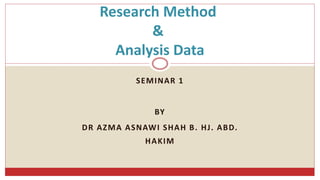
Sem 1_ADS511.pptx
- 1. SEMINAR 1 BY DR AZMA ASNAWI SHAH B. HJ. ABD. HAKIM Research Method & Analysis Data
- 2. Objectives: Understand what is research Understand why we do research Differentiate between basic and applied research Understand quantitative and qualitative research
- 3. What is research? Everyone is researching everyday. - Personal observations, mental models, theories, bias, prejudices and beliefs. To better understand the world around us in the hope that we can improve the human condition; Individual capacities Group capacities National capacities “A process of finding solution to a problem after a studying and analysis of the situational factors” (Sekaran & Bougie, 2013).
- 4. Why Do Research? 1. Explore things we don’t know risky to think we know all testing what we know 2. To understand the variables/dynamics social world is complex figuring out what the elements are to prevent biases, popular beliefs 3. To examine the relationships between them think are not what they seem interactions are dynamic and complex to solve everyday problems, seek better methods, predict and avoid problems
- 5. Basic research vs. Applied research Basic research: discovery, exploration, understanding, explanation. Developing new knowledge. E.g. Understanding the concept and meaning of “melepak” Applied research: prediction, forecasting, productivity improvement, outcome enhancement. It takes existing knowledge to solve problems E.g. Evaluating the impact of cozy and private parks on “melepak” phenomenon in Selangor.
- 6. Quantitative vs. Qualitative Research Quantitative: Assumes objective social reality Social reality is relatively constant across time and space Sees causal relationships among social phenomena from a mechanistic perspective Use numerical data and accuracy; data collected through survey; using methods such as questionnaire and analyzed using statistical tests. (Kumar et. al,2013, p.19)
- 7. Quantitative vs. Qualitative Research Qualitative: Social reality is constructed by its participants Human intentions play major role in explaining causal relationships among social phenomena Use non-numerical data; to explore and understand people’s beliefs, experiences, attitudes, behavior and interactions through methods such as in-depth interviews or focus group discussions . (Kumar et. al,2013, p.19)
- 8. Quantitative vs. Qualitative Research Quantitative Qualitative Studies human behavior in natural or contrived settings. Studies human actions in natural settings. Analyzes social reality into variables. Makes holistic observations of the total context within which social action occurs Uses preconceived concepts and theories to determine what data will be collected Discovers concepts and theories after data have been collected.
- 9. What is Scientific (systematic) Research? Purposive : specific objective Testability : can be verified Rigour : great care in examination Replicability : others can repeat it Precision & confidence : definitional clarity Objectivity : researcher’s biases are reduced or removed Generalisability : can be applied to similar cases Parsimony : identification of the major causes or consequences
- 10. What kind of research is required from students? Original – preferred but not required Empirical / experimental – primary data collection, fieldwork To some extent analytical – relationship between variables with possible cause –effect Scientific – testable, verifiable Demonstrates the one’s understanding of research elements and processes Possible within 2 semester: 1 semester for planning and another for fieldwork and writing up (20 weeks) # More details in Dissertation Guide V 1.0
- 11. Standard Elements of a Research Report 1. Title of the research proposal 2. Statement of the problem / Problem Statement 3. Research questions and objectives 4. Scope of the study 5. Significance of the study 6. Literature review
- 12. Standard Elements of a Research Report 7. Research methodology research design population, sample, sample size and sampling unit of analyses measurement data collection data analysis 8. Findings 9. Discussion & conclusions 10. References (MLA / APA) 11. Appendices